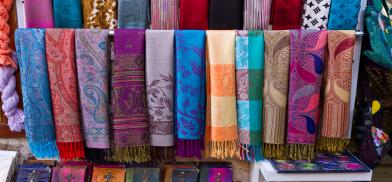World-famous Kashmiri Pashmina: Safeguarding the future of a priceless craft
It was decided to continue such discussions among stakeholders in the coming days to draw up a comprehensive road map for the promotion of the priceless Pashmina craft

As part of a webinar series on Pashmina and its future prospects, domain experts, stakeholders, departmental representatives and INTACH J&K joined a session to discuss the future of the rare and world-famous craft that has fascinated the rich and cognoscenti from all over the world by its magical allure and unmatched grace.
Pashmina is considered the finest craftsmanship in the world which transforms the exceptionally warm and delicate Cashmere threads to opulent accessories, according to pashmina.com. The fleece of Changthangi goat is known as Pashm which is an Urdu word & has origins in Farsi. This goat is exotic and is only found 15000 feet above sea level in Ladakh and Jammu and Kashmir, making the art of Pashmina even rarer and revered all over the world.
Highlighting that the machine intervention has lead to the marginalisation of spinning and weaving activity as a result of which quality of Pashmina products has gone down, Director Handicrafts & HandloomKashmir, Mahmood Ahmad Shah, said that there is an urgent need of reviving the manual de-hairing, spinning and weaving to restore the glory of the Pashmina.
“It has become essential to bring home the point that GI testing and promotion of GI Pashmina is the cornerstone of marketing,” Shah added. "It has became critical to the Pashmina trade that the access to quality supplies from Changthang remains smooth and hassle-free".
Speaking in the webinar Dr. Mohammed Deen, Pashmina expert and founder LEHO Leh, Deen highlighted the various aspects involved in rearing of Pashmina goat (Capra hircus) and problems being faced in view of global warming and issues facing in light of the border flare-ups with Pakistan.
He also highlighted the aspects like decreas ein productivity of alpine pastures and other biotic factors. He said steps have been taken to ensure that the number of goat rearing increased and also the increase in the yield of Pashmina per goat is also achieved.
Ghulam u Din Reshi, Member KCCI talked upon the procurement of Pashmina from Ladakh and the process of hand-spinning in Kashmir to be given fresh impetus.
He also underscored the need to ensure the enhancement of the wages to the hand spinners to re-attract the women folk to the spinning process.
The point of low wages was also highlighted by Tariq Ahmad, President, Kashmir Pashmina Karigar Union and Bashir Ahmad, National Awardee, and Mubashir Shaw, who is a leading exporter of handicrafts, appreciated the fact that the wages of the artisans need to be enhanced for survival of craft in the long run which can happen only by the promotion of GI tagged products.
Babar, Pashmina expert, underscored the need to come out with a brand-building exercise for Kashmir handicrafts products in general in the face of growing competition from other crafts.
Yash Veer Bhatnagar, Scientist, Nature Conservation Foundation, Mysore suggested ways and means of increasing the nutritive value of grasses and ecofriendly intervention to ensure optimal yields of the Pashmina goats.
It was decided to continue such meaningful discussions among stakeholders in the coming days to draw up a comprehensive road map for the promotion of the priceless Pashmina craft, IBNS said. (SAM)








Post a Comment